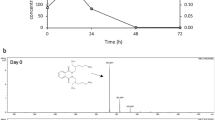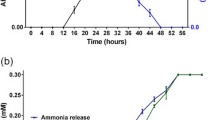Abstract
The toxicities of sodium perfluorononyloxy-benzenesulfonate (OBS) to animals and plants are similar to those of perfluorooctane sulfonate. However, the mechanism of its toxicity to aerobic denitrifying bacteria is still unclear. In the present study, the ecotoxicity of OBS on an aerobic denitrifying strain, Pseudomonas stutzeri, was evaluated. The results showed that a dosage of OBS clearly affected the growth and aerobic denitrification of P. stutzeri. When compared with an unamended control, the degradation efficiency of the total nitrogen decreased by 30.13% during exposure to 200 mg/L of OBS, and the complete degradation time of nitrate-nitrogen was delayed by 4 h. The lactate dehydrogenase and superoxide dismutase produced by the bacteria increased with the concentration of OBS, and reactive oxygen species were also detected by confocal laser scanning microscope imaging. Transmission electron microscope imaging revealed chromosome deformation of the cells and damage to cell content; moreover, outer membrane vesicles were secreted from the bacteria, which was the important detoxification mechanism of P. stutzeri to OBS. Expression of the genes involved in aerobic nitrification and oxidative stress were also changed under OBS stress, which further confirmed the toxicity of OBS to P stutzeri. This study reveals the environmental exposure risk of OBS from the perspective of microorganisms.

Similar content being viewed by others

References
Bao Y, Qu Y, Huang J, Cagnetta G, Yu G, Weber R (2017). First assessment on degradability of sodium p-perfluorous nonenoxybenzene sulfonate (OBS), a high volume alternative to perfluorooctane sulfonate in fire-fighting foams and oil production agents in China. RSC Advances, 7(74): 46948–46957
Beveridge T J (1999). Structures of gram-negative cell walls and their derived membrane vesicles. Journal of Bacteriology, 181(16): 4725–4733
Chen D, Xiao Z, Wang H, Yang K (2018). Toxic effects of vanadium (V) on a combined autotrophic denitrification system using sulfur and hydrogen as electron donors. Bioresource Technology, 264: 319–326
Chen H, Yao J, Wang F, Cai M, Liu H (2013). Toxicity of perfluorooctanoic acid to Pseudomonas putida in the aquatic environment. Journal of Hazardous Materials, 262: 726–731
Chen L, Tsui M M P, Lam J C W, Wang Q, Hu C, Wai O W H, Zhou B, Lam P K S (2019). Contamination by perfluoroalkyl substances and microbial community structure in Pearl River Delta sediments. Environmental Pollution, 245: 218–225
Chen Q, Li T, Gui M, Liu S, Zheng M, Ni J (2017). Effects of ZnO nanoparticles on aerobic denitrification by strain Pseudomonas stutzeri PCN-1. Bioresource Technology, 239: 21–27
Cortez N, Carrillo N, Pasternak C, Balzer A, Klug G (1998). Molecular cloning and expression analysis of the Rhodobacter capsulatus sodB gene, encoding an iron superoxide dismutase. Journal of Bacteriology, 180(20): 5413–5420
Durán N, Durán M, De Jesus M B, Seabra A B, Favaro W J, Nakazato G (2016). Silver nanoparticles: A new view on mechanistic aspects on antimicrobial activity. Nanomedicine; Nanotechnology, Biology, and Medicine, 12(3): 789–799
Ellis T N, Kuehn M J (2010). Virulence and immunomodulatory roles of bacterial outer membrane vesicles. Microbiology and Molecular Biology Reviews, 74(1): 81–94
Giesy J P, Kannan K (2002). Peer reviewed: Perfluorochemical surfactants in the environment. Environmental Science & Technology, 36(7): 146A–152A
Gill S S, Tuteja N (2010). Reactive oxygen species and antioxidant machinery in abiotic stress tolerance in crop plants. Plant Physiology and Biochemistry, 48(12): 909–930
Gui M, Chen Q, Ma T, Zheng M, Ni J (2017a). Effects of heavy metals on aerobic denitrification by strain Pseudomonas stutzeri PCN-1. Applied Microbiology and Biotechnology, 101(4): 1717–1727
Gui M, Chen Q, Ni J (2017b). Effect of sulfamethoxazole on aerobic denitrification by strain Pseudomonas stutzeri PCN-1. Bioresource Technology, 235: 325–331
Hartop K R, Sullivan M J, Giannopoulos G, Gates A J, Bond P L, Yuan Z, Clarke T A, Rowley G, Richardson D J (2017). The metabolic impact of extracellular nitrite on aerobic metabolism of Paracoccus denitrificans. Water Research, 113: 207–214
Ighodaro O M, Akinloye O A (2018). First line defence antioxidants-superoxide dismutase (SOD), catalase (CAT) and glutathione peroxidase (GPX): Their fundamental role in the entire antioxidant defence grid. Alexandria Journal of Medicine, 54(4): 287–293
Jia R, Han C, Lei J L, Liu B L, Huang B, Huo H H, Yin S T (2015). Effects of nitrite exposure on haematological parameters, oxidative stress and apoptosis in juvenile turbot (Scophthalmus maximus). Aquatic Toxicology (Amsterdam, Netherlands), 169: 1–9
Ke Y, Chen J, Hu X, Tong T, Huang J, Xie S (2020). Emerging perfluoroalkyl substance impacts soil microbial community and ammonia oxidation. Environmental Pollution, 257: 113615
Kobayashi H, Uematsu K, Hirayama H, Horikoshi K (2000). Novel toluene elimination system in a toluene-tolerant microorganism. Journal of Bacteriology, 182(22): 6451–6455
Li C (2016). Contamination Characteristics of F-53B, OBS and Other Poly- and Per Fluoroalky Substances in Typical Areas. Master Dissertation. Qingdao: Qingdao Technological University (in Chinese)
Liao T T, Shi Y L, Jia J W, Jia R W, Wang L (2010). Sensitivity of morphological change of Vero cells exposed to lipophilic compounds and its mechanism. Journal of Hazardous Materials, 179(1–3): 10550–1064
Liu G, Zhang S, Yang K, Zhu L, Lin D (2016). Toxicity of perfluorooctane sulfonate and perfluorooctanoic acid to Escherichia coli: Membrane disruption, oxidative stress, and DNA damage induced cell inactivation and/or death. Environmental Pollution, 214: 806–815
Manning A J, Kuehn M J (2011). Contribution of bacterial outer membrane vesicles to innate bacterial defense. BMC Microbiology, 11(1): 258–272
McBroom A J, Kuehn M J (2007). Release of outer membrane vesicles by Gram-negative bacteria is a novel envelope stress response. Molecular Microbiology, 63(2): 545–558
Ning H Q, Li Y Q, Tian Q W, Wang Z S, Mo H Z (2019). The apoptosis of Staphylococcus aureus induced by glycinin basic peptide through ROS oxidative stress response. Lebensmittel-Wissenschaft + Technologie, 99: 62–68
Özen H, Kamber U, Karaman M, Gul S, Atakisi E, Ozcan K, Atakisi O (2014). Histopathologic, biochemical and genotoxic investigations on chronic sodium nitrite toxicity in mice. Experimental and Toxicologic Pathology, 66(8): 367–375
Presentato A, Lampis S, Vantini A, Manea F, Dapra F, Zuccoli S, Vallini G (2020). On the ability of perfluorohexane sulfonate (PFHxS) bioaccumulation by two Pseudomonas sp. strains isolated from PFAS-contaminated environmental matrices. Microorganisms, 8(1): 92
Qian Y, Zhang Y, Zuh A A, Qiao W (2020). New application of rutin: Repair the toxicity of emerging perfluoroalkyl substance to Pseudomonas stutzeri. Ecotoxicology and Environmental Safety, 201: 110879
Qiao W, Xie Z, Zhang Y, Liu X, Xie S, Huang J, Yu L (2018). Perfluoroalkyl substances (PFASs) influence the structure and function of soil bacterial community: Greenhouse experiment. Science of the Total Environment, 642: 1118–1126
Qiao W, Zhang Y, Xie Z, Luo Y, Zhang X, Sang C, Xie S, Huang J (2019). Toxicity of perfluorooctane sulfonate on Phanerochaete chrysosporium: Growth, pollutant degradation and transcriptomics. Ecotoxicology and Environmental Safety, 174: 66–74
Qu B, Zhao H, Zhou J (2010). Toxic effects of perfluorooctane sulfonate (PFOS) on wheat (Triticum aestivum L.) plant. Chemosphere, 79(5): 555–560
Ruan Y, Awasthi M K, Cai L, Lu H, Xu X, Li W (2020). Simultaneous aerobic denitrification and antibiotics degradation by strain Marinobacter hydrocarbonoclasticus RAD-2. Bioresource Technology, 313: 123609
Slotkin T A, Mackillop E A, Melnick R L, Thayer K A, Seidler F J (2008). Developmental neurotoxicity of perfluorinated chemicals modeled in vitro. Environmental Health Perspectives, 116(6): 716–722
Sun Y, Feng L, Li A, Zhang X, Yang J, Ma F (2017). Ammonium assimilation: An important accessory during aerobic denitrification of Pseudomonas stutzeri T13. Bioresource Technology, 234: 264–272
Tang Y, Li M, Xu D, Huang J, Sun J (2018). Application potential of aerobic denitrifiers coupled with a biostimulant for nitrogen removal from urban river sediment. Environmental Science and Pollution Research International, 25(6): 5980–5993
Xu L, Krenitsky D M, Seacat A M, Butenhoff J L, Anders M W (2004). Biotransformation of N-ethyl-N-(2-hydroxyethyl)perfluorooctane-sulfonamide by rat liver microsomes, cytosol, and slices and by expressed rat and human cytochromes P450. Chemical Research in Toxicology, 17(6): 767–775
Yang J, Feng L, Pi S, Cui D, Ma F, Zhao H P, Li A (2020a). A critical review of aerobic denitrification: Insights into the intracellular electron transfer. Science of the Total Environment, 731: 139080
Yang T, Xin Y, Zhang L, Gu Z, Li Y, Ding Z, Shi G (2020b). Characterization on the aerobic denitrification process of Bacillus strains. Biomass and Bioenergy, 140: 105677
Yang X, Ye C, Liu Y, Zhao F J (2015). Accumulation and phytotoxicity of perfluorooctanoic acid in the model plant species Arabidopsis thaliana. Environmental Pollution, 206: 560–566
Zhang M, Li A, Yao Q, Wu Q, Zhu H (2020). Nitrogen removal characteristics of a versatile heterotrophic nitrifying-aerobic denitrifying bacterium, Pseudomonas bauzanensis DN13-1, isolated from deep-sea sediment. Bioresource Technology, 305: 122626
Zheng X, Su Y, Chen Y, Wan R, Liu K, Li M, Yin D (2014). Zinc oxide nanoparticles cause inhibition of microbial denitrification by affecting transcriptional regulation and enzyme activity. Environmental Science & Technology, 48(23): 13800–13807
Zhou S, Zhang Y, Huang T, Liu Y, Fang K, Zhang C (2019). Microbial aerobic denitrification dominates nitrogen losses from reservoir ecosystem in the spring of Zhoucun Reservoir. Science of the Total Environment, 651: 998–1010
Acknowledgements
This research was financially supported by the Natural Science Foundation of Jiangsu Province (BK20201388) and the Priority Academic Program Development of Jiangsu Higher Education Institutions (PAPD).
Author information
Authors and Affiliations
Corresponding author
Ethics declarations
The authors declare that they have no competing interests.
Additional information
Highlights
• OBS inhibited the growth of P. stutzeri and destroyed its structure.
• OBS was toxic to the aerobic denitrification process of P. stutzeri.
• OBS induced the production of ROS in P. stutzeri.
• OBS affected the expression of key genes involved in denitrification and SOD.
Electronic Supplementary Material
Rights and permissions
About this article
Cite this article
Qian, Y., Qiao, W. & Zhang, Y. Toxic effect of sodium perfluorononyloxy-benzenesulfonate on Pseudomonas stutzeri in aerobic denitrification, cell structure and gene expression. Front. Environ. Sci. Eng. 15, 100 (2021). https://doi.org/10.1007/s11783-021-1391-9
Received:
Revised:
Accepted:
Published:
DOI: https://doi.org/10.1007/s11783-021-1391-9



